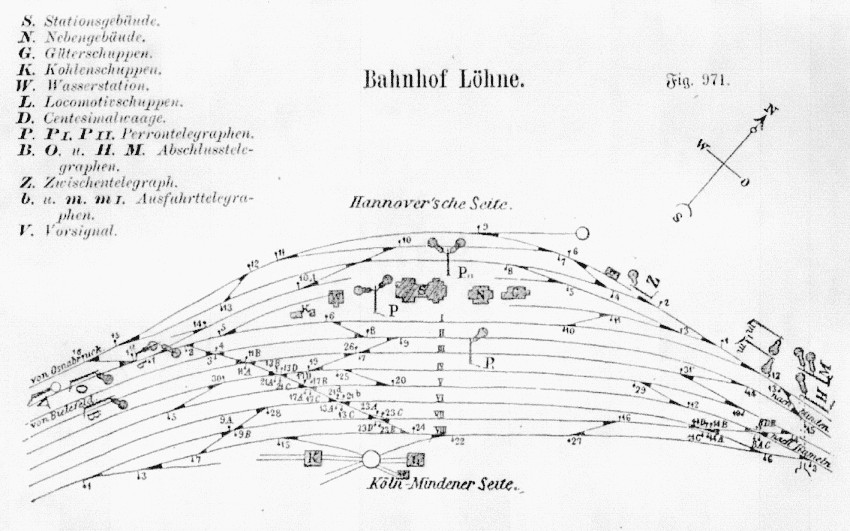Railways in War
Part 2 - German railway preparations for World War One
The Man of Peace
In the summer of 1914, an American journalist and author, Roy Norton
(1870-1942?), was travelling in Germany ... having spent a year
in that country and the previous ten years in Europe.
In the final
weeks before the beginning of the the European War... the Great War ...
World War One ... his final observations included Germany's military
preparations ... and how its citizens were incited by the government to
suddenly go to war. He made several references to Germany's
war railways during this period which appear below.
Soon French,
British - and notably for this website - Canadian railroaders sent to Europe ... would be working against this sophisticated wartime transportation system of Germany's.
Norton's article "The Man of Peace" was published in the series Oxford Pamphlets 1914-1915.
These were articles which worked to explain, justify, and promote
Britain's
involvement in the war. While this website and other accounts focus on
the Western Front in France and Belgium ... "The Only
Front is the Western Front !" ... this was a war which was being fought by the allies
and colonies of
the European great powers ... all around the world ... in Africa, South
America, Asia, and the South Pacific.
Norton's "Man of
Peace" was Germany's Kaiser Wilhelm II
on whose shoulders he squarely placed blame
for the war.
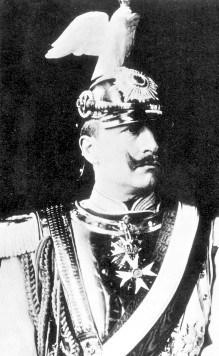
The young Kaiser probably circa 1890.
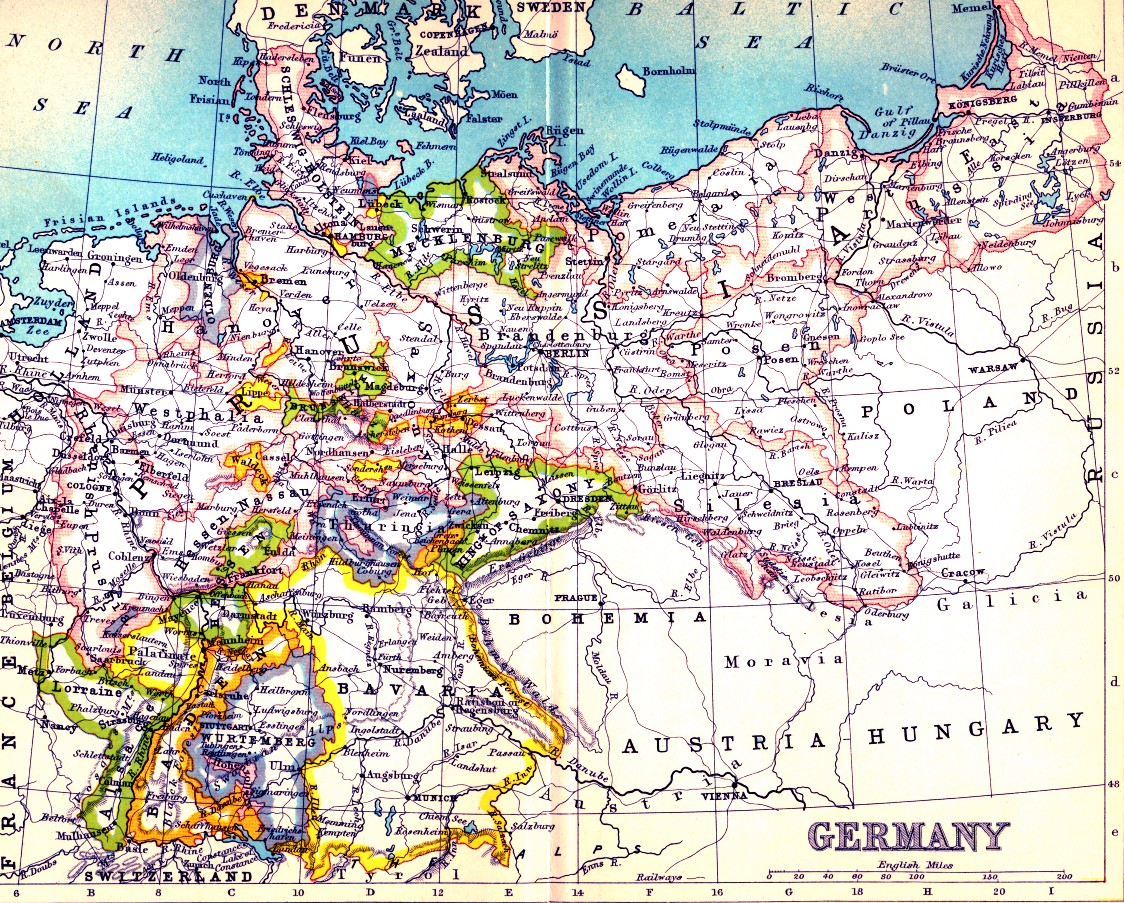
A map of the various states and kingdoms which united to form Germany ... published circa 1900.
Main railway lines and rivers are shown on the map.
Initially there were numerous private railways in Germany, and some Germanic states had their own railways as well.
A Quick Survey of the German Railway System
A
British book on 'Modern Germany', published in 1905, devotes a chapter to German railway
development. It presents German Lessons for the improvement of Britain's railways ... and economy
... and legal system ... and government bureaucracy ...
Railways were a 'British invention' and the Germans imported the
technology along with the idea that private companies would usually
furnish the capital and operate the lines for a profit. Eventually in
such a system, secret tariffs evolve ... which allow railways to
charge more for captive traffic (e.g. your neighbourhood coal mine) and
less for traffic they wish to win.
Strong railways hammer weaker competitors with predatory pricing. There
is generally no 'transparency' for less significant consumers - for example, small shippers or even
individual
railway passengers. Eventually, only the most shrewd and experienced passengers can
travel from Point A to Point B across multiple railway companies
without being gouged or greatly inconvenienced by the multiplicity of
private railway schedules which were never designed to mesh.
Working under Germany's Prussian King in the late 1800s, Prussian
Premier (later German Chancellor) Otto von Bismarck saw railways as
"instruments for conveying the national
traffic" and stated that their acquisition by the state for the general
good was "a matter of course". He cited the systemic problems he
observed :
- Unnecessarily high working expenses and charges, and unnecessary duplication of routes and services.
- Chaos in the various freight charges regimes.
- Movement of goods and passengers nationally was impeded as competitors tried to harm each other.
In 1876-1879 Bismarck worked to bring the railways under state
ownership and control AND to provide preferential rates for freight
shipment WITHIN Germany - to benefit German industries.
State railway ownership increased from 6,300 km in 1879 to 31,000 km by 1902.
Rolling stock on these state lines increased as follows :
|
Locomotives
|
Passenger Cars
|
Freight Cars
|
1879
|
7,152
|
10,828
|
148,491
|
1901
|
13,267
|
24,225
|
303,364
|
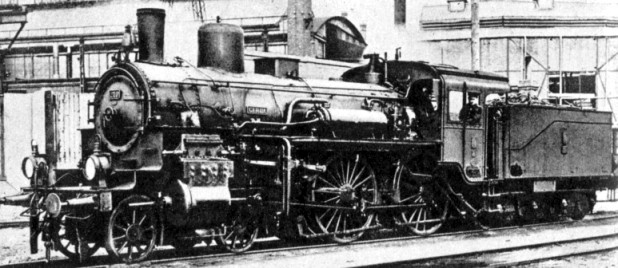
Circa 1900: A Prussian-styled locomotive for fast, medium tonnage passenger trains.
These improvements to Germany's system were noted in 1905 :
"In Great Britain, it requires years
of travel and of careful observation to learn one's way across the
country, and its numerous lines, and to avoid the many pitfalls which
are everywhere placed in the way of the inexperienced traveller. In
Germany, such pitfalls do not exist, and the greatest simpleton will
travel as cheaply, and comfortably, and as rapidly all over the country
as will the most cunning commercial traveller."
"In Germany, railway trains arrive, in nineteen times out of twenty, to
the minute, because the Government punishes severely those who are
responsible for delay."
The author wrote that a new system of freight tariffs had made a
significant contribution to the prosperity of German industries:
"The German freight tariff is of
beautiful simplicity ... every trader possesses a little book by means
of which the office-boy can calculate in a moment the exact amount of
the freight charges for any weight between two stations."
In another review of Foreign Railway Practice published in 1913, an American author noted that:
- Germany generally had the largest and most powerful locomotives
of all European systems. However, they were smaller than the contemporary [North]
American standard.
- Bridge
capacity and tunnel clearances - from earlier construction near the
dawn of railways - limited trains to about 120 axles (maximum : 30
cars with a maximum capacity of 15 tons each).
- Particular engines were assigned to specific engineer/fireman
crews - not 'pooled power'. Only larger power was double-crewed to keep
it working most of the day.
- Firemen arrived for work 2 hours before departure to start the fire and hostle their locomotive.
- Engineers went on duty 1 hour before departure and the engine crew attended to all aspects of locomotive preparation.
- At the end of their assignment, engine crews would stay on duty to attend to any adjustments necessary to their engine.
- After a run, crews were required to be off duty for 8 hours before another assignment.
- Small improvements in fuel efficiency were meticulously recorded ... and reinforced by small rewards from the railway.
- Higher efficiency fuel briquets were manufactured from Germany's
low quality brown coal ... for use when low smoke or additional
evaporative capacity were required.
- "... with the assigned engines the men act as if they were footing the fuel bills themselves ..."
The German state railway reportedly paid lower wages than North American railways.
However, this was offset by the provision of subsidized, well-kept
"living colonies" near urban railway terminals for the crews and their
families. Railway officers (managers) were given family apartments
within their own large terminal buildings - again at a significant
discount.
Elsewhere in the industrialized world, the motivation for creating company towns ran the gamut from benevolent paternalism ... to exploitive avarice
; with the employer's reward ranging from achieving their
Christian duty to their fellow humans ... to effectively enslaving
their employees ("I owe my soul to the Company Store") to satisfy their
selfish greed.
The German state railway "urban colony" perhaps fell between somewhere these two
extremes. The railway's unusual characteristic was that it was an 24 hour
essential operation, to support Germany. As the German state employees
lived on railway property, generally within a large city, their
availability for work without travel delay was assured ... very much like
Schreiber, Ontario once was.
Often people have reflected on the railway culture and its 24 hour demands on workers' lives. With the German system, perhaps it was more like a railway family lifestyle which kept all members of a railway family
in contact with other railway families as their immediate neighbours
... again, much like Schreiber, Ontario once was. It seems likely that
many railway children would follow in their parents' professional
footsteps on the German state railway.
The idea of a German railway lifestyle is probably important to the story of World War One ...
The railroaders were accustomed to living and working together ...
and behaved as if they 'owned' their equipment and 'footed the bill' for its fuel.
Failing to stay on schedule was a serious transgression in peacetime.
With a loyal, cohesive group of railroaders conditioned to follow standardized procedures ...
one can imagine that German troop and supply trains would run like clockwork.
If only such a fine system had been used ... for goodness ... and niceness ...
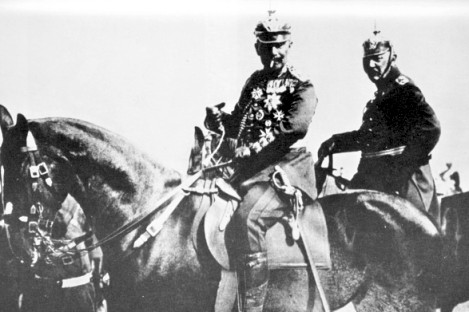
Military Man (of Peace)
Kaiser Wilhelm II enjoying a butt in the saddle ...
on military exercises with
Helmuth von Moltke, Chief of the German General Staff
Excerpts from
A Man of Peace
It was told me in March, of this year, by one who is
almost as great a military editor as there is in the "Fatherland", that the completion of the improved Kiel
canal was the very last act that possibly could be effected
in "preparedness".
[The
greatest value of the Kiel Canal was as a German navy shortcut between
the Baltic and North Seas. On the map above, see: Denmark, then go
south to the 'H' in Holstein for the canal location.]
" From now onward ", declared this man, " Germany
needs nothing more than the natural increase in her navy,
and maintenance of her efficiency in arms. At present we
are probably armed better than any other nation in the
world. We have adequate reasons for confidence that
this is so. Our military railways are now perfected."
It did not dawn on me at that time that usually,
when a man's preparations to do something have been
perfected, he finds a way to go ahead and do that thing
of which he has dreamed and for which he has prepared.
I did observe, however, that scattered over Germany
were more of those wonderful "switch" or "shunting"
yards, capable of entraining tens of thousands of soldiers
in a few hours yards where from ten to twenty passenger
trains could be drawn up at one time, and oddly enough,
some of these queer yards, all equipped with electric
lighting plants, are out in places where there are not
a dozen houses in sight. In some of these yards, located
at central points for rural mobilization, one saw long
trains of troop cars, dingy, empty, stodgily waiting for
use in war, if one ever came. I was told of one test
mobilization (in reply to my query as to why I had seen
so many troops pass through a small place one evening),
where twenty thousand men were assembled at ten
o'clock one morning, made a camp complete, were reviewed,
entrained, detrained, and just seven hours later
there was nothing save debris and trampled grass to show
that the place had ever been disturbed.
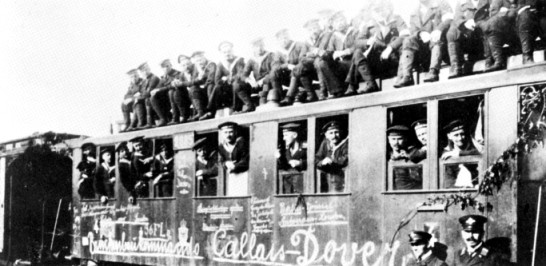 German sailors being mobilized.
German sailors being mobilized.
At a mere "Tank-station" [i.e. the location of a water tank to
replenish locomotive tenders with no civilian settlement] below Kriesingen, on June 12, I saw
probably
seventy-five or a hundred locomotives (I had time to count more than
seventy), most of which were of antiquated type obsolete as far as the
demands of up-to-date traffic are concerned and of a kind that would
have been "scrapped" in either England or America. Yet these were all
being cared for and "doctored up". A few engineers and stokers worked
round them, and I saw them run one down a long track and bring it back
to another, whereupon hostlers at once began drawing its fires, and the
engineer and stoker crossed over and climbed into another cab.
"What do you suppose they are doing that for ?"
I asked one of the train men with whom I had struck
up an acquaintance.
"Why," replied he with perfect frankness, "those are
war locomotives."
Reading the look of bewilderment on my face, he
added, "You see, those engines are no longer good
enough for heavy or fast traffic, so as soon as they
become obsolete we send them to the reserve. They
are all of them good enough to move troop trains, and
therefore are never destroyed. They are all frequently
fired up and tested in regular turn. Those fellows out
there do nothing else. That is their business, just keeping
those engines in order and fit for troop duty. There
are dozens of such depots over Germany."
"But how on earth could you man them in case of
war ? Where would you get the engineers for so many
extras ?"
He smiled pityingly at my ignorance.
"The head-quarters know to the ton what each one
of those can pull, how fast, where the troop cars are
that it will pull ; and every man that would ride behind
one has the number of the car he would ride in, and for
every so many men there is waiting somewhere a reserve
engineer and stoker. The best locomotives would be
the first out of the reserve, and so on down to the
ones that can barely do fifteen kilometres per hour."
Since that June day, Germany has proved how faithfully those thousands of reserve locomotives over her
domain have been nursed and cared for, and how
quickly those who were to man and ride behind them
could respond.
Originally from an 1885 German railway
education textbook - 15 years after the Franco-Prussian War - 29 years
before the Great War :
A railway terminal schematic diagram as part of a standardized state railway curriculum.
At this point, almost as I write, I had something
explained to me over which I have at times puzzled
for months. On February 14 of this year I was in
Cologne, and blundered, where I had no business, into
what I learned was a military-stores yard. Among
other curious things were tiny locomotives loaded on
flats which could be run off those cars by an ingenious
contrivance of metals, or, as we call them in America,
rails. Also there were other flats loaded with sections
of tracks fastened on cup ties (sleepers that can be
laid on the surface of the earth) and sections of miniature
bridges on other flats. I saw how it was possible
to lay a line of temporary railway, including bridges,
almost anywhere in an incredibly short space of time,
if one had the men. At one period of my life I was
actively interested in railway construction, but had
never before seen anything like this. Before I could
conclude my examination I discovered that I was on
verboten ground, and had to leave ; but the official
who directed me out told me that what I had seen
were construction outfits. The more I thought of
those, afterwards, the more I was puzzled by the absence
of dump cars, and that mass of smaller paraphernalia
to which I had been accustomed in all the contracting
work I had ever seen. Yet I had to remember with
admiration the ingenuity of the outfit, and think of
how quickly it could all be laid, transferred, re-shipped,
or stored. Here before me, in a letter received from
Holland but yesterday, which comes from a Hollander
who was a refugee in Germany, and on August 30 [1914 - after the war had begun]
reached home after trying experiences, is the following
:
Never, I believe, did a country so thoroughly get
ready for war. I saw the oddest spectacle, the building
of a railway behind a battle-field. They had diminutive
little engines and rails in sections, so they could be
bolted together, and even bridges that could be put
across ravines in a twinkling. Flat cars that could
be carried by hand and dropped on the rails, great
strings of them. Up to the nearest point of battle
came, on the regular railway, this small one. At the
point where we were, it came up against the soldiers.
It seemed to me that hundreds of men had been trained
for this task, for in but a few minutes that small portable
train was buzzing backward and forward on its
own small portable rails, distributing food and supplies.
It was great work, I can tell you. I've an idea that
in time of battle it would be possible for those sturdy
little trains to shift troops to critical or endangered
points at the rate of perhaps twenty miles an hour,
keep ammunition, batteries, &c., moving at the same
rate and, of course, be of inestimable use in clearing
off the wounded. A portable railway for a battle-field
struck me as coming about as close to making war
by machinery as anything I have ever heard of. I did
not have a chance, however, to see it working under
fire, for, being practically a prisoner, I was hurried
onward and away from the scene.
I know of nothing more than this, coming from one
whom I know to be truthful, that so adequately shows
how even ingenious details had been worked out for
military perfection. We shall doubtless hear, after this
war is over, how well those field trains performed their
work when it came to shifting troops in times of fierce
pressure on a threatened point, and how it added to
German efficacy.
The reader will perhaps ask by this time, "What has all this to do with
responsibility for the war ?" I answer, "When the reader was a boy and
by various efforts and privations saved money enough to buy a box of
tools, did he lock them up in the garret, or bury them in the cellar ?
When he possessed a fine bright Billy Barlow pocket-knife, did he
whittle with it ?" However, this is not an argumentative thesis, and a
good witness confines himself to what he personally considers relative,
and to personal events that may or may not be regarded as significant.
I hold no brief one way or the other.
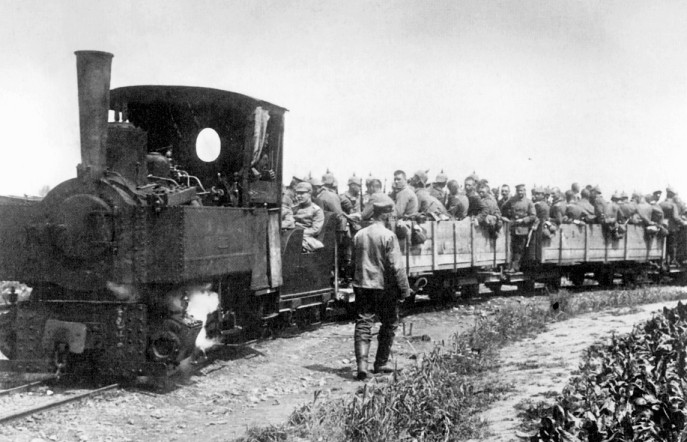 A narrow gauge German battlefield railway early in the war.
A narrow gauge German battlefield railway early in the war.
As Part 3 will show, both sides made use of light railway systems in the battlefields.
[After observing German shore battery and naval exercises,
and having been warned by a
friend in late July 1914 to leave Germany immediately via Switzerland,
Norton
make the following observation]
It is needless to say that I was in Berlin and packing on
the following day, that immediately after I did go to
Switzerland, and that still there was no open declaration
of war on Germany's part. I stopped at Basle for a
while, interested in that fine frontier station, and one
day was amused by the extremely expressive swearing
of a man who I found out was a "switchman" in the
yards. He was complaining of over-work.
"One might have an idea", he growled, "that Germany
was going to war, from the way the German railways are
ordering all their empty trucks returned from everywhere.
Nothing but empties going home, and if anybody
makes a mistake or overlooks one, there's the devil
to pay !"
I have since learned that this inflow of empty German
carriages and trucks was so observable at other frontier
stations, that two weeks before war was declared the
German yards were swamped with this excess.
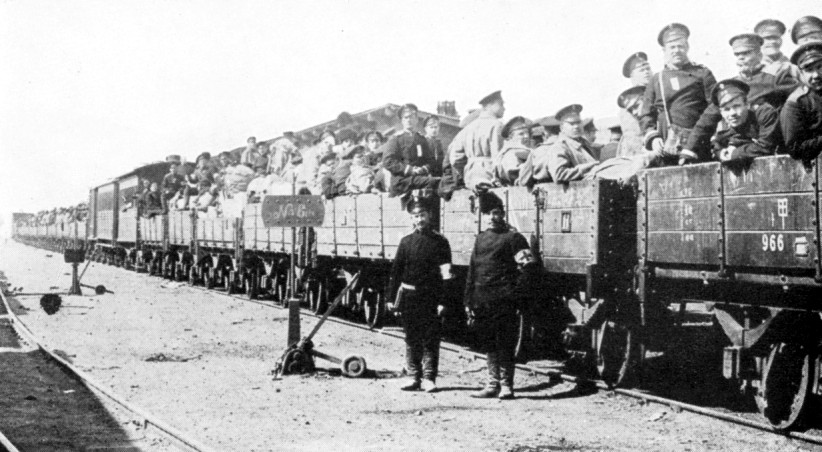
Mind the Steppes
Slowly assembling from the vast expanse of the Russian Empire, the Czar's army is heading for East Prussia.
Passenger coaches have been provided for the officers, perhaps for food service as well.
Everyone else rides in the Vista-Liners.
With Russia's railways being of a 5 foot gauge (to impede invasion by
rail) it will be necessary to march west from the border ...
unless the Germans have thoughtfully left some 4 foot 8 1/2 inch
'standard gauge' equipment sitting around for their convenience.
Technically, Germany declared war on Russia just before it declared war on Russia's ally France.
Practically, it needed the Schlieffen Plan to work in France ...
so the victorious German army could quickly ride the rails of the German state railway east to stop the Russians.
Back to sitemap






